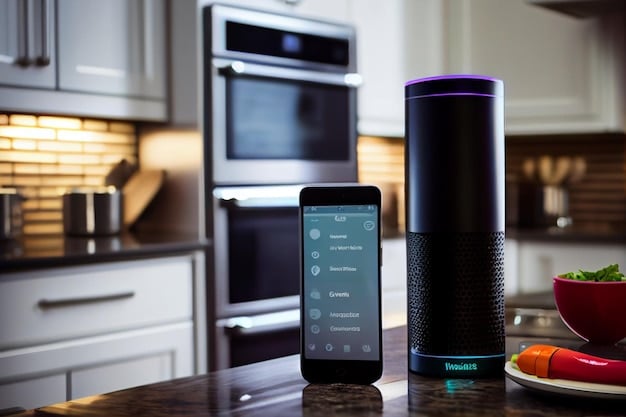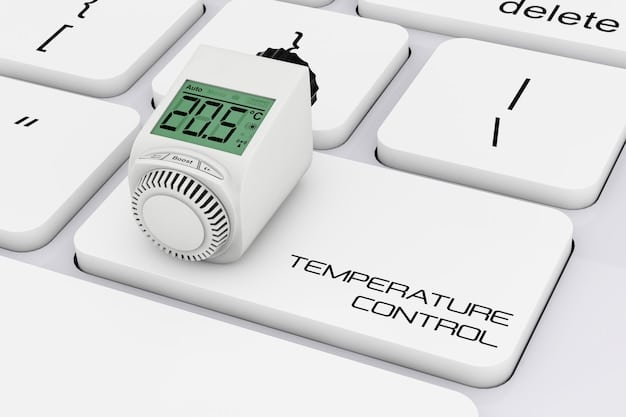Is Your Smart Home a Fire Hazard? 7 Steps to Prevent Electrical Fires in 2025

Smart homes offer convenience, but the increasing number of connected devices raises concerns about electrical fire hazards; this article outlines seven essential steps to prevent electrical fires in your smart home, ensuring safety in 2025 and beyond.
Is your smart home truly safe? While offering unprecedented convenience, the proliferation of connected devices may significantly increase the risk of electrical fires. Understanding this potential danger is the first step to safeguarding your home; this guide provides 7 essential steps to prevent electrical fires in your smart home fire hazard? 7 steps to prevent electrical fires in 2025, ensuring a safer and more secure living environment for you and your family.
Understanding the Increased Fire Risk in Smart Homes
The integration of smart technology into our homes has brought unparalleled convenience and efficiency. However, this increased reliance on interconnected devices also presents new challenges, particularly in the form of heightened electrical fire risks. Before 2025, it’s important to explore the key factors contributing to this elevated danger.
Let’s understand in detail about the increase of fire risks in our smart homes.
The Proliferation of Connected Devices
Each new smart device added to your home network increases the overall electrical load and complexity of the electrical system.
Increased Strain on Electrical Systems
Many older homes were not designed to handle the power demands of today’s technology-rich lifestyles, leading to overloaded circuits and potential fire hazards.
- Overloaded circuits: Smart devices plugged into a single outlet can easily overload the circuit, leading to overheating and potential fires.
- Worn Wiring: Older homes frequently have aged wiring that is more susceptible to damage and failure under constant heavy loads.
- DIY installations: Incorrectly installed smart devices, especially those involving electrical wiring, can introduce critical safety risks.
Recognizing these risks is the first step in mitigating them. Protecting your home from electrical fires requires a proactive approach, beginning with simple awareness and regular inspections.
Step 1: Conduct a Thorough Home Electrical Inspection
The first line of defense against electrical fires in a smart home is a comprehensive inspection of your home’s electrical system. This step is critical for identifying potential vulnerabilities and rectifying them before they escalate into dangerous situations. It’s a good idea to schedule these inspections before adding extra automation.
Let’s understand how to conduct a thorough home electrical inspection.

Hiring a Qualified Electrician
A certified electrician has the tools and knowledge to accurately assess the state of your electrical system, checking for code compliance, wear and tear, and potential hazards.
Key Inspection Points to Look For
The electrician will typically examine all visible wiring, outlets, and electrical panels, as well as specific areas prone to issues. Here’s what they should look for:
- Check wiring: Look for frayed, cracked, or exposed wires, which can lead to short circuits.
- Test outlets and switches: Ensure outlets and switches are functioning properly and are not overheating or emitting sparks.
- Assess electrical panels: Verify that the electrical panel is properly labeled, and circuit breakers are correctly sized for their circuits.
Regular electrical inspections can uncover hidden issues and provide peace of mind, ensuring that your electrical system is safe and up to par with the demands of your smart home.
Step 2: Upgrade Outdated Wiring and Electrical Panels
If an electrical inspection reveals outdated or inadequate wiring and electrical panels, upgrading them is essential. Modern smart homes demand more power, and older systems often cannot handle this increased load safely. Upgrading can protect against fire hazards and ensure that your home can support your technology needs.
Here are a few ways on how to do this in an orderly matter.
Identifying the Need for Upgrades
Signs that your electrical system may need an upgrade include frequent tripped circuits, flickering lights, and warm outlets or switches.
Choosing the Right Upgrades
Upgrading might involve replacing old wiring with new, higher-gauge wires, installing a new electrical panel with sufficient capacity, and adding additional circuits to distribute the load.
- Replace old wiring: Replace aluminum wiring with copper which is more conductive and less prone to corrosion.
- Install a new panel: Choosing a panel with additional capacity allows you to safely add more devices without overloading the system.
- Add circuits: Distributing the electrical load across multiple circuits minimizes the risk of overloading any one circuit.
Investing in electrical upgrades is a worthwhile investment in your home’s safety, especially as you integrate more smart devices. A modern, well-maintained electrical system ensures that you can enjoy the benefits of smart technology without compromising your safety.
Step 3: Use Surge Protectors and Power Strips Wisely
Surge protectors and power strips are essential tools for protecting your smart home devices from electrical surges. However, they must be used correctly to be effective. Understanding the types of surge protectors available and how to use power strips wisely can significantly reduce the risk of electrical damage and fire.
Surge protectors can also help prevent a dangerous power surge.
Types of Surge Protectors
Various types of surge protectors are available, ranging from whole-house surge protectors to individual outlet surge protectors. Each type offers different levels of protection and is suitable for different applications.
Best Practices for Power Strips
Using power strips safely involves avoiding overloading them, using only UL-listed power strips, and discarding any strip that shows signs of damage.
- Whole-house surge protectors: Installing a whole-house surge protector at your electrical panel provides comprehensive protection against surges entering from outside power lines.
- Individual surge protectors: These protect specific devices and are ideal for expensive gadgets like TVs, computers, and smart home hubs.
- Avoid overloading: Do not plug in too many devices, which can cause overheating and fire hazards.
By implementing these practices, you can greatly enhance your home’s electrical fire safety, ensuring that your devices are protected and your risk is minimized.
Step 4: Properly Install and Maintain Smart Devices
Improperly installed and maintained smart devices is a significant source of electrical fires in smart homes. Following manufacturer guidelines and regularly checking devices for wear and tear can greatly reduce this risk. Also, ensuring that installations are done correctly and maintenance is performed consistently prevents many potential electrical issues.
Let’s check into how to do it properly and maintaining these.
Following Manufacturer Instructions
Always adhere to the manufacturer’s instructions for installation and usage to avoid incorrect setups that might lead to electrical issues. It can also cause problems with proper use.
Regular Maintenance Checks
Schedule routine inspections and tests of your smart devices to identify any signs of damage or wear that could lead to electrical hazards. It is also important to know the devices that don’t last long.
- Check for damage: Look for frayed wires, damaged plugs, and other signs of physical wear.
- Test devices: Periodically test safety features like automatic shut-off to ensure they are functioning correctly.
- Update software: Keep device software updated to prevent malfunctions caused by outdated code.
Proper installation and consistent maintenance of smart devices safeguard against electrical fires and prolong the lifespan of your technology.
Step 5: Monitor Smart Home Devices for Overheating
Overheating smart home devices can indicate underlying electrical issues that, if left unaddressed, may lead to a fire. Regularly monitoring your devices for signs of overheating and promptly addressing any concerns can help prevent such incidents. Also, preventing devices from overheating can significantly impact the risk of fire.
Here are a few things to keep an eye on.
Identifying Overheating Signs
Learn to recognize signs of overheating, such as unusual smells, abnormally warm devices, or discoloration of device components.
Using Smart Home Monitoring Systems
Integrate smart home monitoring systems that provide alerts on temperature anomalies or unusual electrical usage to proactively identify potential problems.

- Check temperatures: Regularly feel devices to ensure they are not excessively warm, especially power adapters and smart plugs.
- Listen for unusual sounds: Be aware of any buzzing, crackling, or hissing sounds that may indicate an electrical issue.
- Review energy usage: Use smart energy monitors to track usage patterns and identify spikes that could indicate a problem.
By staying vigilant and reacting quickly to any signs of overheating, you can significantly reduce the risk of electrical fires and ensure the safety of your home.
Step 6: Install and Maintain Smoke Detectors and Fire Extinguishers
Smoke detectors and fire extinguishers are indispensable safety tools for any home, particularly those equipped with smart technology. Regular testing and maintenance of these devices ensure they are ready to protect you in the event of a fire. This step is crucial for early detection and quick response to contain or extinguish a fire.
You need to get the right smoke detectors and maintenance.
Strategic Placement of Smoke Detectors
Install smoke detectors on every level of your home, inside each bedroom, and outside sleeping areas to maximize early detection capabilities.
Fire Extinguisher Types and Maintenance
Keep a fire extinguisher accessible on each floor, ensure it is rated for electrical fires (Class C), and check it annually to ensure it is fully charged.
- Test monthly: Press the test button on each smoke detector monthly to ensure the batteries are functioning.
- Replace batteries: Change the batteries in your smoke detectors at least once a year, preferably in the spring or fall.
- Check extinguisher pressure: Verify the pressure gauge is in the green zone, indicating it is properly charged.
Having working smoke detectors and readily available fire extinguishers enhances your ability to respond quickly and effectively to a fire, minimizing potential damage and protecting lives.
Step 7: Practice Electrical Safety Habits
Consistent electrical safety habits are essential for preventing fires in smart homes. Simple precautions can significantly reduce the risk of electrical incidents. Incorporating these practices into your daily routine will create a safer living environment for everyone in your household.
Here are a few habits to adapt to.
Unplug Unused Devices
Unplug devices when they’re not in use to reduce phantom loads and the risk of electrical surges from lightning strikes.
Avoid Overloading Outlets
Spread the electrical load by plugging devices into different circuits to avoid overloading any single outlet or circuit.
- Avoid extension cords: Use extension cords only temporarily and never as a permanent wiring solution.
- Keep flammable materials away: Ensure curtains, bedding, and other flammable materials are kept away from heat sources and electrical outlets.
- Educate family members: Teach family members about electrical safety, including how to respond to an electrical fire.
By adopting these safety habits, you create a mindful approach to electrical use, reducing the risks associated with smart home technology and enhancing the overall safety of your home.
| Key Point | Brief Description |
|---|---|
| 💡 Electrical Inspection | Schedule a professional home electrical inspection. |
| 🔌 Wiring Upgrade | Upgrade outdated wiring to handle modern smart device load. |
| 🛡️ Surge Protection | Use surge protectors to safeguard against electrical surges. |
| 🔥 Safety Habits | Regularly check devices for overheating and adopt electrical safety habits. |
FAQ
▼
It’s advisable to have a professional electrical inspection every three to five years, or sooner if you notice signs of electrical problems.
▼
Key signs include frequent tripped circuits, flickering lights, and outlets or switches that feel warm to the touch.
▼
A Class C fire extinguisher is designed for electrical fires, using a non-conductive agent to safely extinguish the flames.
▼
Unplugging devices reduces phantom loads and protects against electrical surges, saving energy and minimizing fire risks.
▼
Ensure devices have adequate ventilation, avoid covering them, and monitor their temperature regularly to prevent overheating.
Conclusion
While smart homes offer incredible convenience, it’s vital to proactively address potential fire hazards to ensure safety. By following these seven steps—conducting regular inspections, upgrading electrical systems, using surge protectors, installing devices correctly, monitoring for overheating, maintaining safety devices, and practicing safe habits—you can significantly reduce the risk of electrical fires and protect your home and family.





